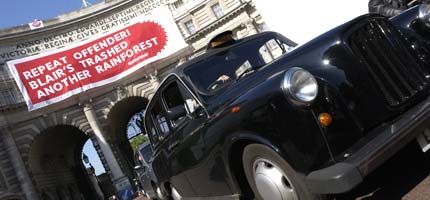
You couldn't make it up. After having been exposed no less than three times already for using illegal timber in their building projects, Tony Blair's government has done it again.
As revealed on BBC2's Newsnight, our latest investigation has revealed that wood ripped from the rainforests of Papua New Guinea is being used right at the heart of government in the Houses of Parliament. This latest gaff comes as the Cabinet Office finally owns up and admits the plywood used around Admiralty Arch this summer was also poorly sourced.
As part of a £ million plan to restructure the Press Area, plywood faced with bintangor, a tropical hardwood sourced almost exclusively from Papua New Guinea, is being used to protect the hallowed floors, stairs and walls during building work.
We traced the source of the timber from the Houses of Parliament, through the timber mills of China and back to the spectacular rainforests of Papua New Guinea. It's here that 'robber barons' commit a variety of crimes, including rape, torture and bribery as well as illegal logging, to acquire the timber and export it. So it's the rainforest that needs protecting, not the corridors of power.
As reported in the Guardian, a spokesperson for L&G Timber, who supplied the plywood, said that "if certified sustainable wood had been requested, we would have supplied it".
If you're feeling a sense of déja vu, you're not alone. In 2001, Tony Blair promised they would only use legal and sustainable timber but since then we've caught them using illegal timber from Cameroon at the Cabinet Office in 2002 and again at the Home Office with Indonesian wood in 2003.
But it was only in July that we revealed how Admiralty Arch, home to the Cabinet Office and the Prime Minister's Strategy Unit, was surrounded by plywood hoardings exactly the same to those now in the Palace of Westminster. At the time, the Cabinet Office released a statement saying: "We have a contract with the company [Allenbuild] which requires them to obtain their wood from legal sustainable sources. They have provided certification to show they have done so."
We asked to see this certification but unsurprisingly it wasn't forthcoming. A journalist who also asked to see it was told the fax machine was broken and it couldn't be emailed. Since then we've continued to ask for proof. Finally, we've received their own internal report, which has confirmed that the plywood was indeed as dodgy as it comes. No doubt there are some red faces in Westminster right now.
So we have to ask the question, when will they get it right? It's not as if they don't know the problem exists - after all, we've told them often enough - and they know what needs to be done. Enforce their own policies to ensure all timber in government projects comes from accredited sources, such as those certified by the Forest Stewardship Council (FSC), and ban all imports of illegally logged timber into the UK.
Earlier this year, even the Timber Trade Federation, the organisation that represents UK timber merchants, advised its members not to use any timber from either Papua New Guinea or the Solomon Islands. If the industry itself is taking steps to avoid illegal timber, surely the government can as well.
It's painful having to repeat yourself so many times and we really do want the government to get this right, because if they do it will be a colossal step forward in closing down the UK as a market for illegal timber. The government accounts for around 20 per cent of all timber used in this country, and with the wider public sector that rises to 40 per cent. If all that had to be FSC-certified, imagine what an impact that would have.




